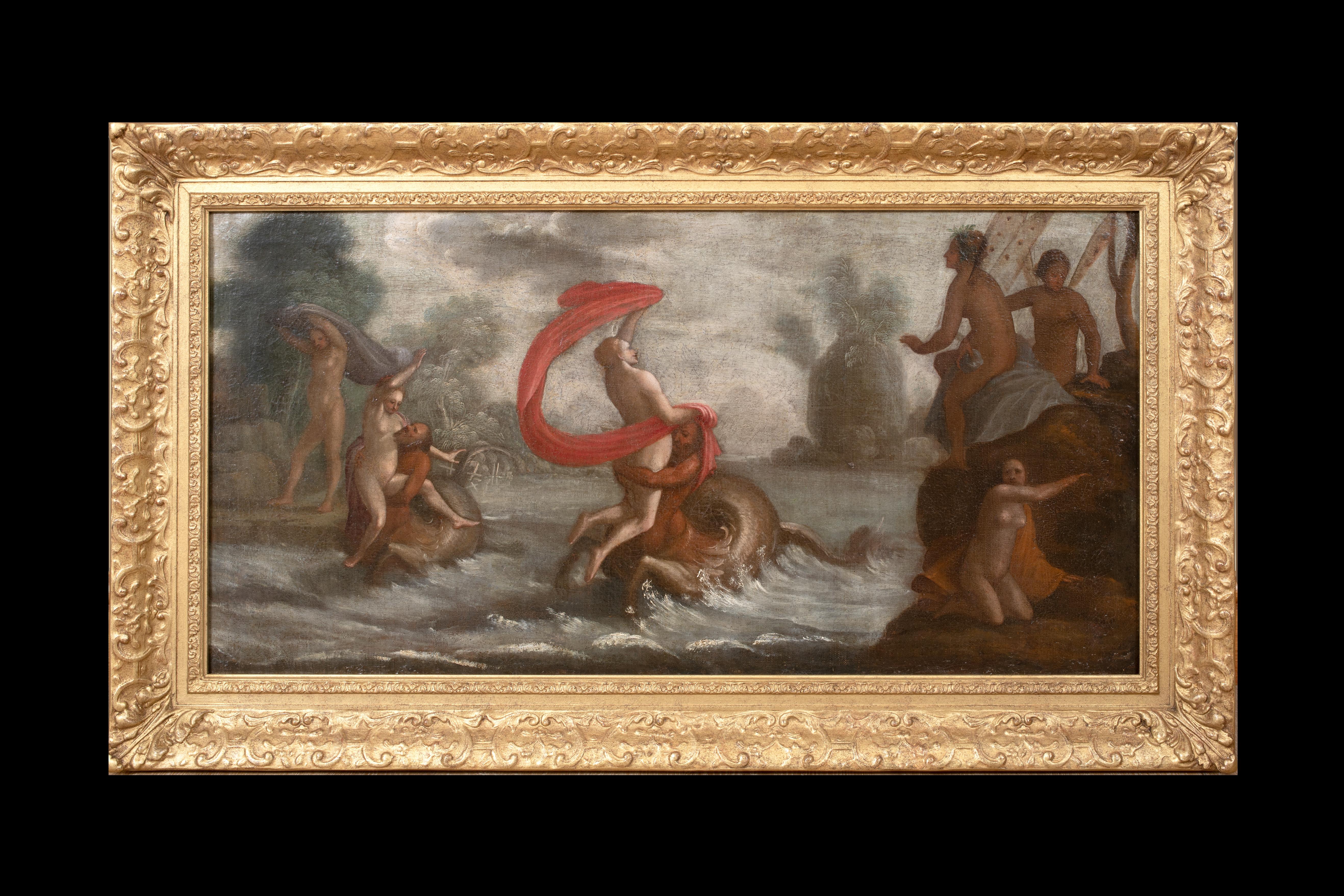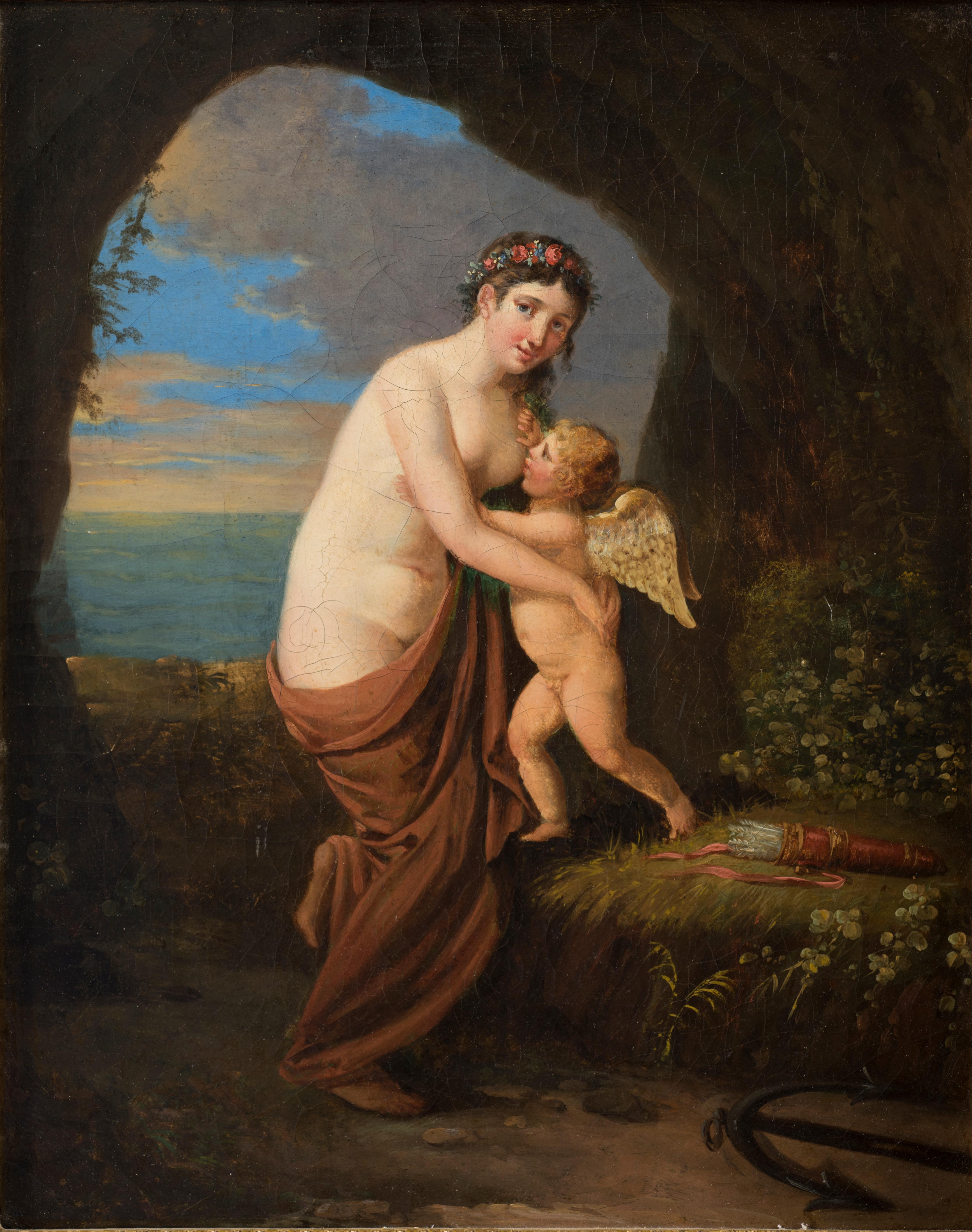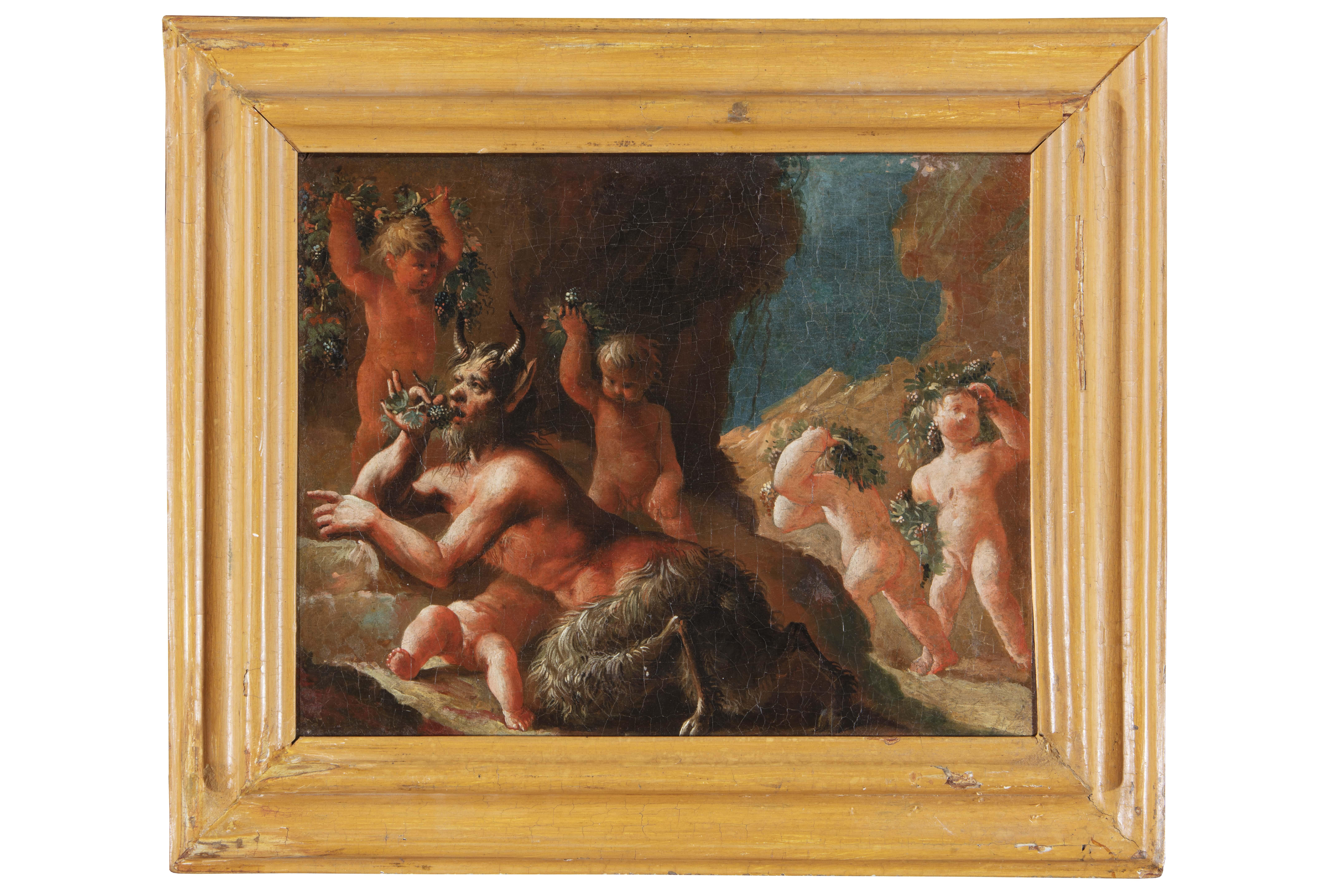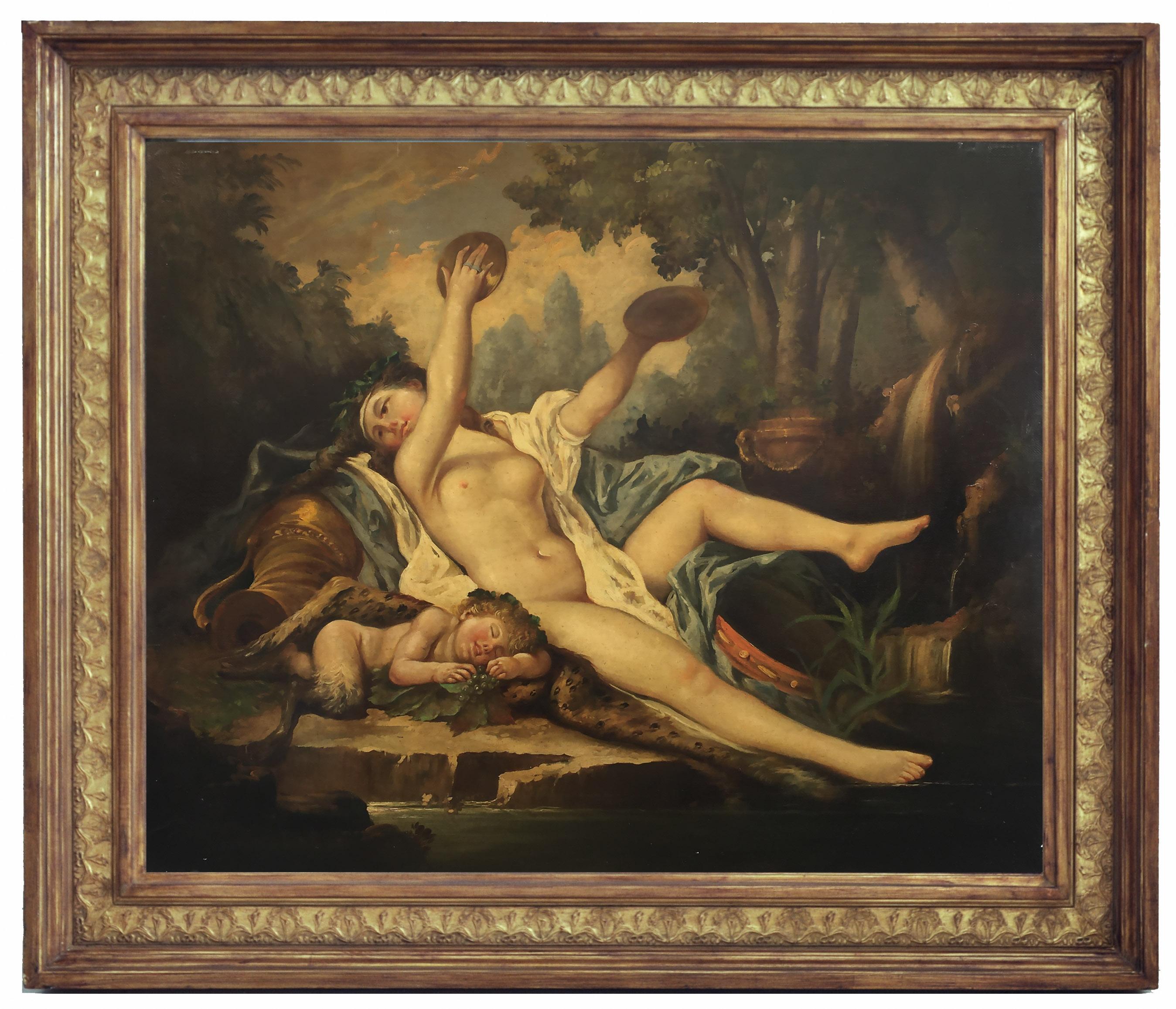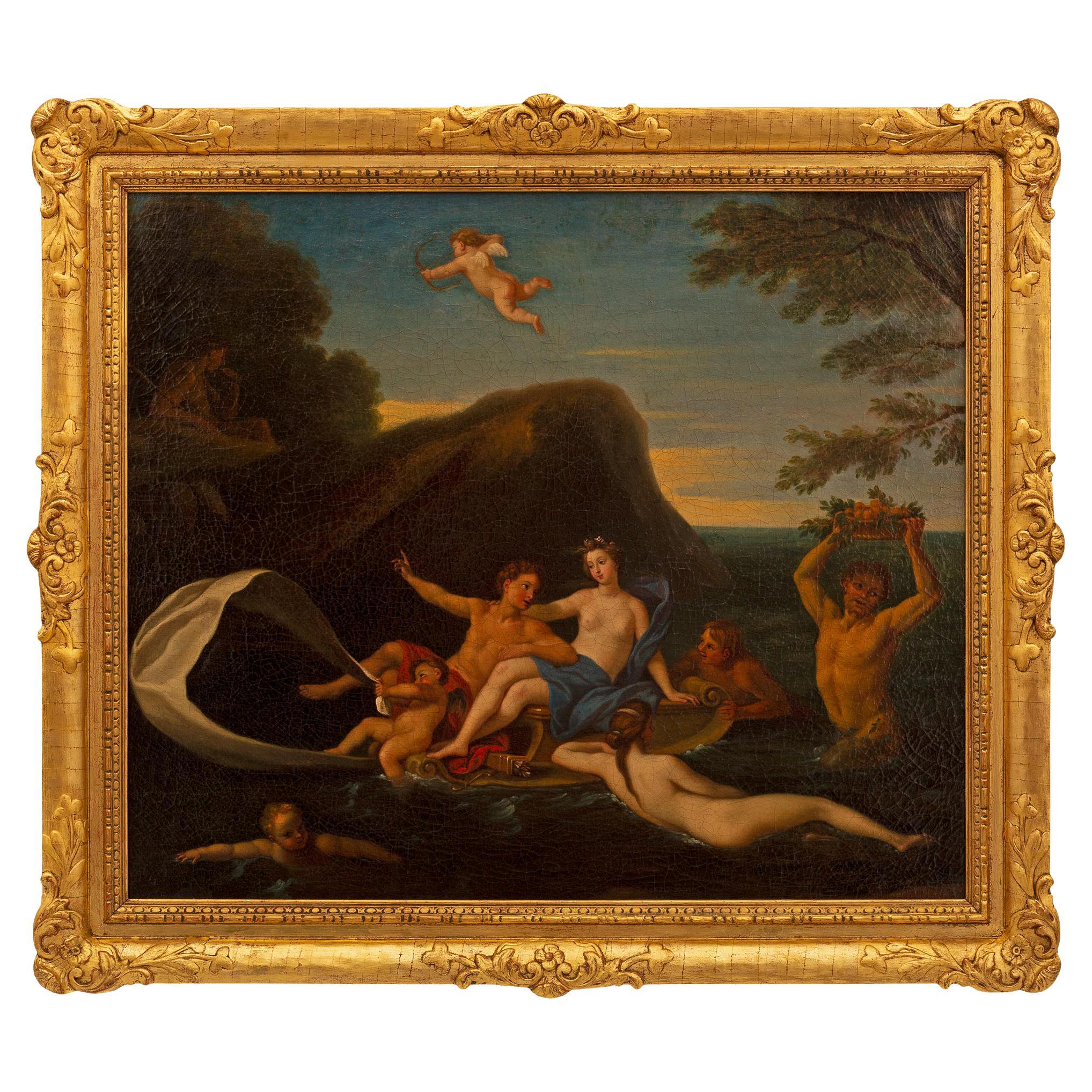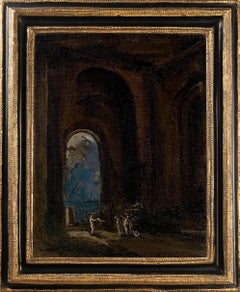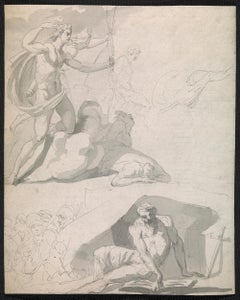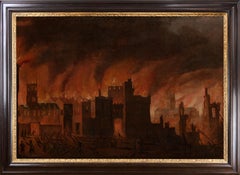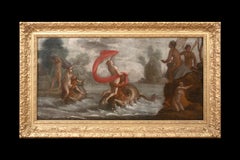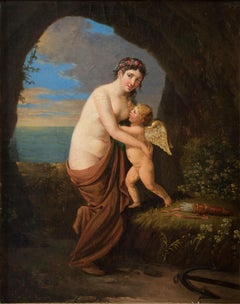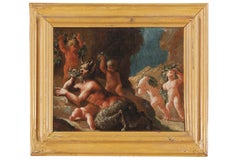Items Similar to 18th century allegorical painting of The Triumph of Beauty
Want more images or videos?
Request additional images or videos from the seller
1 of 7
Edward Dayes18th century allegorical painting of The Triumph of Beauty1799-1800
1799-1800
$249,119.40
£180,000
€212,850.60
CA$340,989.65
A$381,926.44
CHF 198,729.02
MX$4,638,469.92
NOK 2,519,379.10
SEK 2,377,221.86
DKK 1,588,168.55
Shipping
Retrieving quote...The 1stDibs Promise:
Authenticity Guarantee,
Money-Back Guarantee,
24-Hour Cancellation
About the Item
Exhibited:
London, Royal Academy, 1800, no. 93
What was happening in British history painting in around 1800? In recent discussions of the emergence of a British School of history painting following the foundation of the Royal Academy in 1768, this is a question which is rarely posed and one which is not easily answered. Examination of surviving Royal Academy exhibition catalogues reveals a profusion of artists’ names and titles, few of which remain immediately recognizable, whilst endeavours to explain the impact of exhibition culture on painting - such as the 2001 Courtauld show Art on the Line - have tended to focus on the first and second generation of Royal Academician, rather than young or aspiring artists in the early nineteenth century. This makes the discovery and identification of the work under discussion of exceptional importance in making sense of currents in English painting around 1800. Executed by Edward Dayes and exhibited in the Great Room at Somerset House in the summer of 1800, it is a remarkable essay in the aspirations of historical painting and the Reynoldsian ‘grand manner’ from a painter more generally known for his topographical watercolours. It stands simultaneously as a compelling document of Dayes’s attempts to use the apparatus of history painting to advance his career and perfect example of the Academy aesthetic in the decade after the death of Reynolds.
Edward Dayes was one of the most highly regarded topographical draughtsman of the second half of the eighteenth century but it was known that towards the end of his career – which was cut tragically short by his suicide in 1804 – he exhibited a number of historical works at the Royal Academy. The appearance of a sketchbook containing over 100 studies for historical compositions raised the possibility that a number of previously unattributed subject-pictures may in fact be by Dayes. Amongst the designs is a small wash study for the Origins of Beauty.
Born in 1763, he was apprenticed to the mezzotinter and miniaturist William Pether and entered the Royal Academy Schools on 6 October 1780. He made his début at the academy in 1786, showing in the next few years a mixture of portraits, miniatures, topographical watercolours, and figure subjects; in all Dayes showed sixty-four works at the Royal Academy. Dayes rapidly established himself as a successful draughtsman for the print trade, undertaking commissions at every level. Eleven plates after his works were engraved for the Copper Plate Magazine between 1794 and 1797, and he contributed more than forty scenes for John Aiken's Description of the Country from Thirty to Forty Miles Round Manchester published in 1795. In 1789 Thomas Girtin was apprenticed to Dayes and whilst he is always seen as representing the antithesis of Girtin and Turner’s Romantic approach to watercolour, their earliest works are in fact indistinguishable from Dayes’s. What is more, Dayes's Instructions for Drawing and Colouring Landscapes (1805) suggests he was an innovative thinker on professional practice and on the teaching of watercolour techniques, including sketching in colours from nature.
From 1798 Dayes spent an increasing amount of his time painting scenes from the Bible and from the works of Dryden and Milton. His diary for 1798 gives a detailed account of his work on four watercolours, including the striking image of 'The Fall of the Angels' (exh. RA, 1798; Tate collection). The following year he began the present canvas in oils, a move that was a logical progression for Dayes, ambitious for a career as a serious history painter. For the subject matter Dayes turned to the work of the mid-eighteenth century poet, Mark Akenside. In the 1800 exhibition catalogue published by the Academy, Dayes included seven lines from Akenside’s 1744 didactic poem, The Pleasures of the Imagination to inform the subject of the Origins of Beauty. Dayes’s composition was both a literal transcription of Akenside’s account of a standing ‘Venus’ in her ‘pearly car’, surrounded by ‘Tritons’ and ‘cerulean sister[s] of the flood’, and a distillation of the poet’s Platonic concept of beauty itself.
The extent of Dayes's ambition was underlined in his theoretical ‘Essays on painting’, published in the Philosophical Magazine for 1801–2, which outlined the ideal method for preparing an historical composition. Dayes commended the young painter to begin with a rough sketch, which he was to ‘prune or add till the whole comes into perfect ordonnance,’ adding finally ‘complete the whole by slightly tinting it.’ A ‘tinted’ drawing of the composition survives in the British Museum sketchbook revealing Dayes’s debt to the Medici Venus in the conception of the figure. But Dayes’s composition had more immediate precedents than the antique. In 1772 James Barry had shown his Venus Rising from the Sea (Dublin City Art Gallery) at the Academy. The study in the British Museum sketchbook, gives an idea of the original composition, which included Cupid seated in the clouds, bow in hand, to the right of Venus. This detail recalled Barry’s composition, where Cupid is seen standing behind Venus on a bank of cloud. Recent analysis has shown that it was an element which Dayes included in his initial execution of the design, along with putti seated in the clouds to the left of Venus, but decided to paint them out before completing the picture.
The choice of subject was remarkably in tune with other pictures in the 1800 exhibition. Benjamin West showed Venus at her Birth Attired by the Graces (private collection). West’s Venus is posed very similarly to Dayes’s, with one hand raised to her head and the face shown in profile, although the palette and execution are completely different. Dayes follows his own suggestions as articulated in his essays, that handling and colour should reflect the subject matter of the painting. Thus the figure of Venus is finely modelled, ‘clean and fair’ in a blond palette, whilst the tritons are ‘dusky or muddy’ by contrast painted in a reddish-brown tone.
The painting was well placed in the Great Room, but in the end it received relatively little critical notice, its proximity to a canvas by the Academy’s President of a similar subject and format cannot have helped. It was not a propitious moment for Dayes to embark upon a career as a history painter. The apparent opportunities offered by entrepreneurial publishers, such as John Boydell and Charles Macklin, had ended in financial disaster by 1800; a situation compounded by the end of the European market for luxury goods brought about by the Napoleonic wars. Another consequence of which, was that London was flooded with fine old master paintings dislodged from the Continent - the exhibition of the Italian paintings from the Orléans collection in Pall Mall had opened in December 1798 - serving to depress the market for contemporary works. Dayes’s composition exemplified the type of paintings which were being produced for the Royal Academy in around 1800.
- Creator:Edward Dayes (1763 - 1804, English)
- Creation Year:1799-1800
- Dimensions:Height: 50 in (127 cm)Width: 36 in (91.44 cm)
- Medium:
- Movement & Style:
- Period:
- Condition:Preserved in very good condition.
- Gallery Location:London, GB
- Reference Number:1stDibs: LU150727720292
About the Seller
5.0
Recognized Seller
These prestigious sellers are industry leaders and represent the highest echelon for item quality and design.
1stDibs seller since 2021
- ShippingRetrieving quote...Shipping from: London, United Kingdom
- Return Policy
Authenticity Guarantee
In the unlikely event there’s an issue with an item’s authenticity, contact us within 1 year for a full refund. DetailsMoney-Back Guarantee
If your item is not as described, is damaged in transit, or does not arrive, contact us within 7 days for a full refund. Details24-Hour Cancellation
You have a 24-hour grace period in which to reconsider your purchase, with no questions asked.Vetted Professional Sellers
Our world-class sellers must adhere to strict standards for service and quality, maintaining the integrity of our listings.Price-Match Guarantee
If you find that a seller listed the same item for a lower price elsewhere, we’ll match it.Trusted Global Delivery
Our best-in-class carrier network provides specialized shipping options worldwide, including custom delivery.More From This Seller
View All18th century oil sketches for a Baroque interior - a pair
Located in London, GB
A FEAST OF THE GODS WITH VENUS AND BACCHUS
Collections:
With Appleby Brothers, London, June 1957;
Hazlitt, Gooden & Fox, London, 1961;
John and Eileen Harris, acquired from the above, to 2015.
Literature:
Jacob Simon and Ellis Hillman, English Baroque Sketches: The Painted Interior in the Age of Thornhill, 1974, cat. no.12 (as by Louis Laguerre);
Elizabeth Einberg (ed.), Manners and Morals: Hogarth and British Painting, 1700-1760, exh. cat., London (Tate Gallery), 1987, cat. no.10 (as by Louis Laguerre);
Tabitha Barber and Tim Bachelor, British Baroque: Power and Illusion, exh. cat., London (Tate Britain), 2020.
Exhibited:
Twickenham, Marble Hill House, English Baroque Sketches: The Painted Interior in the Age of Thornhill, 1974, no.12 (as by Louis Laguerre);
London, Tate Gallery, Manners and Morals: Hogarth and British Painting, 1700-1760, 1987, no.10 (as by Louis Laguerre);
London, Tate Britain, British Baroque: Power and Illusion, cat. no 92, 2020.
CUPID AND PSYCHE BEFORE JUPITER
Collections:
With Appleby Brothers, London, June 1957;
Hazlitt, Gooden & Fox, London, 1961;
Anthony Hobson, acquired from the above, to 2015.
These recently re-united paintings are the most ambitious surviving baroque ceiling sketches made in Britain in the early eighteenth century. From the Restoration until the rise of Palladianism in the 1720s decorative history painting formed the preeminent artistic discipline in Britain. It was a field dominated by Continental artists including the Italian Antonio Verrio and the Frenchmen Louis Laguerre and Louis Chéron...
Category
Early 18th Century Baroque Figurative Paintings
Materials
Canvas, Oil
20th century oil painting entitled The Unknown Corner
Located in London, GB
Collections:
Robert Isaacson;
James Draper, New York, 2014.
Exhibited:
Cambridge, The Fitzwilliam Museum, Beggarstaffs: William Nicholson and James Pr...
Category
Early 20th Century Modern Figurative Paintings
Materials
Canvas, Oil
Eighteenth century Old Master drawing - Apollo destroying Niobe's children
By John Hamilton Mortimer
Located in London, GB
Pen, ink and wash
Framed dimensions: 13 x 11 ¼ inches
Drawn c.1765
Verso: a study of a hanged man
Mortimer has filled this small sheet with action, depicting in the top right, Apollo and Artemis...
Category
18th Century Old Masters Figurative Drawings and Watercolors
Materials
Ink, Pen
Early oil depicting the Great Fire of London
Located in London, GB
The Great Fire of London in September 1666 was one of the greatest disasters in the city’s history. The City, with its wooden houses crowded together in narrow streets, was a natural fire risk, and predictions that London would burn down became a shocking reality. The fire began in a bakery in Pudding Lane, an area near the Thames teeming with warehouses and shops full of flammable materials, such as timber, oil, coal, pitch and turpentine. Inevitably the fire spread rapidly from this area into the City. Our painting depicts the impact of the fire on those who were caught in it and creates a very dramatic impression of what the fire was like. Closer inspection reveals a scene of chaos and panic with people running out of the gates. It shows Cripplegate in the north of the City, with St Giles without Cripplegate to its left, in flames (on the site of the present day Barbican). The painting probably represents the fire on the night of Tuesday 4 September, when four-fifths of the City was burning at once, including St Paul's Cathedral. Old St Paul’s can be seen to the right of the canvas, the medieval church with its thick stone walls, was considered a place of safety, but the building was covered in wooden scaffolding as it was in the midst of being restored by the then little known architect, Christopher Wren and caught fire. Our painting seems to depict a specific moment on the Tuesday night when the lead on St Paul’s caught fire and, as the diarist John Evelyn described: ‘the stones of Paul’s flew like grenades, the melting lead running down the streets in a stream and the very pavements glowing with the firey redness, so as no horse, nor man, was able to tread on them.’
Although the loss of life was minimal, some accounts record only sixteen perished, the magnitude of the property loss was shocking – some four hundred and thirty acres, about eighty per cent of the City proper was destroyed, including over thirteen thousand houses, eighty-nine churches, and fifty-two Guild Halls. Thousands were homeless and financially ruined. The Great Fire, and the subsequent fire of 1676, which destroyed over six hundred houses south of the Thames, changed the appearance of London forever. The one constructive outcome of the Great Fire was that the plague, which had devastated the population of London since 1665, diminished greatly, due to the mass death of the plague-carrying rats in the blaze.
The fire was widely reported in eyewitness accounts, newspapers, letters and diaries. Samuel Pepys recorded climbing the steeple of Barking Church from which he viewed the destroyed City: ‘the saddest sight of desolation that I ever saw.’ There was an official enquiry into the causes of the fire, petitions to the King and Lord Mayor to rebuild, new legislation and building Acts. Naturally, the fire became a dramatic and extremely popular subject for painters and engravers. A group of works relatively closely related to the present picture have been traditionally ascribed to Jan Griffier...
Category
17th Century Old Masters Landscape Paintings
Materials
Oil, Canvas
18th century portrait of the Royal Academy model George White
By John Russell
Located in London, GB
Collections:
Russell sale, Christie’s, 14 February, 1807: ‘John Russell, Esq., R.A. deceased, crayon painter to His Majesty, the Prince of Wales, and Duke of York; and brought from his late Dwelling in Newman Street’, lot 92, ‘St Peter’, bt. Thompson (£1.13s);
Anonymous sale; Sotheby's, London, 25th September 1980, lot 113;
Private collection, UK, 2016.
Literature:
Martin Postle, 'Patriarchs, prophets and paviours: Reynolds's images of old age', The Burlington Magazine, vol. cxxx, no. 1027, October 1988, pp. 739-40, fig. 9;
Martin Postle, Sir Joshua Reynolds: The Subject Pictures, Cambridge, 1995, p.136, repr.;
Neil Jeffares, Dictionary of pastellists before 1800, online edition, J.64.2928.
Signed and dated: J Russell/ fecit 1772 (lower right)
Framed dimensions: 25 x 31 inches
John Russell was admitted to the Royal Academy in March 1770, at the same time as Daniel Gardner. The nascent Academy Schools were still establishing their teaching structures, but central to the syllabus were the twin components of drawing after the antique and from life models. By 1772 Russell had already been awarded a silver medal and progressed to the life academy, where he produced this remarkable pastel study of George White. White was the most famous model employed by the Royal Academy and prominent artists in the second half of the eighteenth century. A paviour – or street mender –by profession White had been discovered by Joshua Reynolds, who in turn introduced him to the Academy. Russell’s striking head study demonstrates his abilities as a portraitist and pastellist, at the same time showing his interest in the Academy’s preoccupation with promoting history painting.
George White was one of the most celebrated models in eighteenth-century London. According to the painter Joseph Moser:
'Old George…owed the ease in which he passed his latter days, in a great measure to Sir Joshua Reynolds, who found him exerting himself in the laborious employment of thumping down stones in the street; and observing not only the grand and majestic traits of his countenance, but the dignity of his muscular figure, took him out of a situation to which his strength was by no means equal, clothed, fed, and had him, first as a model in his own painting room, then introduced him as a subject for the students of the Royal Academy.'
As Martin Postle has pointed out, whilst characterful studies of old men posed as biblical figures, prophets or saints by Continental old masters were readily available on the art market – Reynolds himself had copied a head of Joab by Federico Bencovich in the collection of his friend and patron, Lord Palmerston - finding a model in Britain from whom to execute a painting was more difficult.
White therefore offered a rare opportunity for artists to combine portraiture and history painting, by painting a model in the guise of an historical or literary character. In 1771 Reynolds showed at the Royal Academy a picture of White entitled Resignation. It was engraved in 1772 and accompanied by a stanza from Oliver Goldsmith’s Deserted Village, implying a literary context to what is essentially a portrait. In his annotated Royal Academy catalogue, Horace Walpole noted: ‘This was an old beggar, who had so fine a head that Sir Joshua chose him for the father in his picture from Dante, and painted him several times, as did others in imitation of Reynolds. There were even cameos and busts of him.’ White sat to, amongst others Johan Zoffany, John Sanders, Nathaniel Hone and the sculptor John Bacon...
Category
18th Century Old Masters Portrait Drawings and Watercolors
Materials
Pastel
Portraits of the Hon. Mary Shuttleworth and Anna Maria, 9th Baroness Forrester
By Daniel Gardner
Located in London, GB
THE HON. MARY SHUTTLEWORTH, NÉE COCKBURN (D. 1777)
and her sister
ANNA MARIA, 9TH BARONESS FORRESTER (D. 1808)
Pastel and gouache on paper laid on canvas, on their original backb...
Category
18th Century Old Masters Portrait Drawings and Watercolors
Materials
Pastel, Gouache
You May Also Like
Diana Boullogne Mythological Paint Oil on canvas old master 17/18th Century
Located in Riva del Garda, IT
Bon Boullogne (Paris, 1649 - Paris, 1717) workshop of
Episodes from the myth of Diana
oil painting on canvas
Dimensions: 84 x 114 cm.
with antique frame 100 x 132 cm.
The beautiful painting proposed shows a series of episodes taken from the myth of the divinity Diana, the Roman divinity of hunting, forests and wild animals, masterfully captured in this valuable painting, which shows a luxuriant wood, a favorite place of the divinity, as a theater of his adventures.
The composition opens, on the left, with a sort of presentation of the divinity, portrayed as an attractive young girl, surrounded by her faithful Nymphs, one of whom holds her quiver with arrows, and by one of her beloved dogs. hunting her.
The 'story' continues in the central part where we can see the divinity during a wild boar hunt...
Category
Late 17th Century Old Masters Paintings
Materials
Oil
$8,473 Sale Price
20% Off
The Triumph Of Galatea, 19th Century follower of Scarsellino (1550-1620)
Located in Blackwater, GB
The Triumph Of Galatea, 19th Century
follower of Scarsellino (1550-1620)
Large 16th 17th Century Italian Old Master of the Triumph of Galatea, oil on canvas. Excellent quality and ...
Category
17th Century Portrait Paintings
Materials
Canvas, Oil
$5,535 Sale Price
20% Off
Allegorical Scene, Aphrodite and Eros - Oil on Canvas - Late 18th / Early 19th
Located in Roma, IT
Allegorical Scene is a superb original oil painting on canvas, realized by an anonymous artist during Neoclassicism's years.
This old master's artwork offers us un unprecedented ap...
Category
Late 18th Century Figurative Paintings
Materials
Oil
18th century By French Maestro Bacchanal Oil on canvas
Located in Milano, Lombardia
18th Century French Maestro
Title: Bacchanal
Medium: Oil on canvas
Dimensions: without frame 24 x 30 cm - with frame 33.5 x 39 cm
Antique shaped wooden frame lacquered in mustard col...
Category
18th Century Old Masters Figurative Paintings
Materials
Canvas, Oil
ALLEGORICAL SCENE - Giovanni Faliero - Italy Oil on Canvas Painting
By Giovanni Faliero
Located in Napoli, IT
Allegorical Scene - Giovanni Faliero Italia 2009 - Oil on canvas cm. 90x110.
Gold leaf gilded wooden frame available on request
This beautiful oil on canvas is the personal reinterpretation of the magnificent painting “Bacchant playing the Cymbals” by Jean-Simon Berthélemy, a French painter of the 18th century. Here we admire a mythological scene showing a naked bacchant playing cymbals next to a wooded stream, with a small sleeping faun...
Category
Early 2000s Old Masters Portrait Paintings
Materials
Canvas, Oil
Continental 19th Century Oil On Canvas Painting In Its Original Giltwood Frame
Located in West Palm Beach, FL
An outstanding Continental 19th century oil on canvas painting in its original giltwood frame. The beautiful painting depicts Venus at the center laying on a boat with a young man at...
Category
Antique 19th Century Unknown Paintings
Materials
Canvas, Giltwood
More Ways To Browse
Thomas Day
European Painting 18th Century
Edward Mayer
18th Century English Painting
Prints Of 18th Century Paintings
Antique Copper Painting
100 Year Old Painting
18th Century British Paintings
Antique Round Painting
Paintings From 1800s
Antique Angel Paintings
18th Century English Oil Paintings
18th Century Putti
Cupid Painting
Mid Century Turner
The Disasters Of War
Painting With Cupids
Paintings Of Putti
